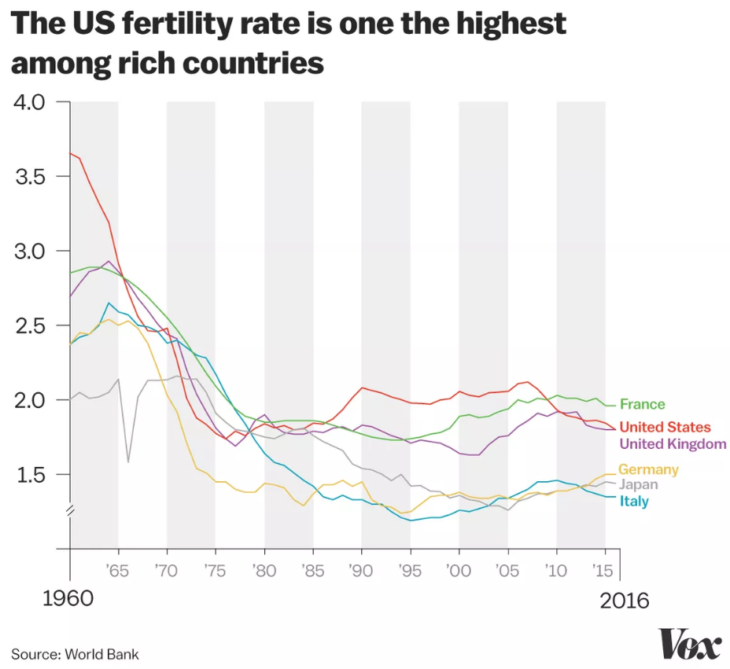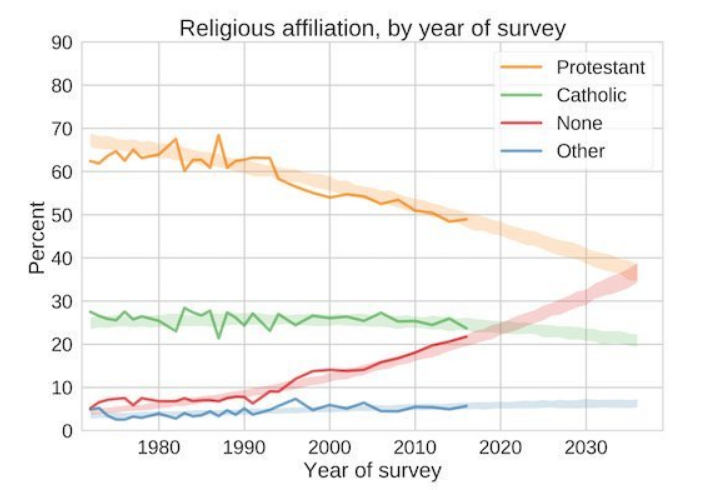
The Wall Street Journal just reported some new Census data, which shows that the US population grew at the slowest rate in 80 years between July 2017 and July 2018. At first I wondered if this reflected a slowdown in immigration, but that doesn’t seem to be the biggest factor:
As birthrates have dropped and death rates risen, immigration’s role in the nation’s continuing population growth has expanded. Last year, it accounted for 48% of the country’s growth, up from 35% in 2011. Accounting for arrivals and departures, the Census Bureau estimated that the country gained 979,000 people from abroad last year, close to the annual average of 1 million in recent years. The figure accounts for both legal and unauthorized immigration, as well as the movement of Americans moving abroad and back.
As I predicted, the Trump administration is not having a major impact on the overall rate of immigration, even as it makes it harder for certain categories of people to immigrate. Indeed, I predict that in the long run Trump will have caused immigration to be higher than otherwise, as he pushes the Democrats into a more extreme pro-immigration stance. Look for the next President to sharply reverse course and increase immigration—especially from Asia.
Back in the 1990s and early 2000s, the US had a much higher birthrate than Europe. While the birthrate is still a bit higher, the gap has narrowed sharply. The US birthrate is still much higher than in Germany and Italy, but lower than in France and about the same as the UK:
 The US population has gone from growing about one percentage point faster than the EU in the 1990s, to perhaps a third of a point faster today.
The US population has gone from growing about one percentage point faster than the EU in the 1990s, to perhaps a third of a point faster today.
So what other ways is the US becoming more like Europe?
1. The percentage of Americans who are not religious has been rising dramatically.

2. Our health care system is increasingly socialized.
3. Our politics increasingly resembles the populism of places like Hungary and Italy. The political polarization resembles the Brexit split in the UK. Anti-immigration nationalism came on the scene in Europe before it hit the US.
4. The recent criminal justice reform bill slightly (and I emphasize slightly) moves us in the European direction of lower rates of incarceration. We are also slightly softening the war on drugs.
5. Walkable shopping areas are increasingly popular. Some cities are moving to allow dense townhouses in areas previously reserved for single-family homes.
What am I missing?
In terms of monetary policy, the population slowdown makes the US more susceptible to hitting the zero bound in interest rates. Not surprisingly, one of the few countries to avoid the zero bound during the Great Recession was Australia, which has fast population growth.

READER COMMENTS
Ahmed Fares
Dec 21 2018 at 2:14pm
“The percentage of Americans who are not religious has been rising dramatically.”
While this is true, there has also been a rise in spirituality. In 2014, the BBC reported that in that year, Rumi was the best-selling poet in America. Rumi is a Sufi master, one of the people of Sufism, the mystical branch of Islam.
The decline in mainstream Christianity parallels the rise in education starting in the 1960’s. As people become more educated, religion no longer satisfies them and they begin to yearn for spirituality. If they can’t find it in their own religion, they’ll seek it elsewhere.
http://www.bbc.com/culture/story/20140414-americas-best-selling-poet
KV
Dec 24 2018 at 1:13am
Ahmed, can you distinguish between religion and spirituality in a way that fits the data? It is true that almost all nones identify as spiritual and possess many non-scientific, religious beliefs about the afterlife, souls, reincarnation, and New Age beliefs in the power of crystals, etc. Perhaps what you mean is that as people leave mainline Protestantism, they are moving into religious beliefs and practices that are non-Christian and that is a bit of a smorgasbord of warmed-over Eastern practices and beliefs. But that’s not really a function of education levels. We are seeing more secularization among the non-college educated than the college educated. Moreover, there is a case to be made that political polarization is driving secularization, which is occurring disproportionately among white male liberals. Religion is associated with being right-wing, being left-wing has become more important than religion. (There’s a similar trend on the right, with people who identify as conservative becoming more religious, but it is outweighed by the trend on the left.)
Ahmed Fares
Dec 25 2018 at 4:27pm
“they are moving into religious beliefs and practices that are non-Christian and that is a bit of a smorgasbord of warmed-over Eastern practices and beliefs.”
Actually, they’re moving closer to true Christianity.
Christianity is an esoteric religion in the allegorist tradition. It was covered up in 325 AD at the Council of Nicaea where it was labeled the “gnostic heresy”. It is elements of gnostic Christianity which show up in the Qur’an and by extension in Sufism. When Christians read mystic writings, they sense the essence of Christianity there.
As for what you mentioned, I agree that you can slice and dice people up into many different categories as regards their religious and/or spiritual beliefs. I mentioned the rise in education, and I would add further the impact of the internet, that has allowed people to become more aware of other religions and traditions.
As regards education, a lot of people have their first exposure to other religions in comparative religion classes in university. Often, that can be the start of lifelong learning in that respect.
Also, there was 9/11. I noticed that a lot of people suddenly developed a great interest in Islam just after the attacks. There’s a saying that wars are how Americans learn geography. I would add that terrorism is how Americans learn religion.
Scott Sumner
Dec 21 2018 at 3:30pm
Ahmed, Good point.
Floccina
Dec 21 2018 at 4:26pm
The developed world where genes go to die (except Amish, Mennonite and Hasidic Jewish genes).
Mark Z
Dec 21 2018 at 5:42pm
Why “especially from Asia?”
Regarding declining fertility and religiosity, these aren’t peculiarly European things; they’re just what happens as countries become more developed, and I think both trends can be observed throughout most of the world. And I’m still skeptical of these putative broad global political trends (or at least that they’re of lasting import, rather than so much sound and fury). In the course of the next couple years it’s quite likely both the US and UK will be governed by socialists (I consider it doubtful Joe Biden will run and so Sanders seems to be the front-runner) and the SPD in Germany and whatever party exists in France in a few years will likely displace the centrist incumbents. In short it’s looking fairly likely that in 3 or 4 short years the political landscape of the Western world will look the opposite of how it looks today.
KV
Dec 24 2018 at 1:10am
It is not true that the world is getting less religious as it becomes more developed. Eastern Europe and Russia are becoming more religious, and there’s been a massive Chinese conversion towards Christianity and Islam. The US has seen a modest decline in self-identification as religious, one that is closer to its historic norm that high points in the 50s and 80s. Most sociologists of religion now reject the secularization hypothesis on which declining religious belief is a natural function of the progress of science and education.
Benjamin Cole
Dec 21 2018 at 7:51pm
The US Federal Reserve, by overtightening, is doing all it can to bring a socialist president to the US.
The next President of the United States may be Bernie Sanders.
Who knows? Maybe he will be an improvement from the current administration.
Scott Sumner
Dec 21 2018 at 9:08pm
Mark, Asian immigration is rising, and more and more displacing Latin American immigration. Given that most humans are Asian, I expect that trend to continue. Also, many Asians prefer living in America relative to Europe.
Maybe the underlying trend is anti-elite populism, and Sanders/Corbyn are part of that trend. For some Trump voters, Sanders was their second choice.
BC
Dec 22 2018 at 3:32am
The religion chart doesn’t include the fastest growing religion, the Church of Wokeness, with its purely ritual demonstrations like plastic straw abstinence and its periodic purges and cleanses of heretical Halloween costumes and Christmas songs.
Todd Kreider
Dec 24 2018 at 1:25am
A Pew survey was just released a couple of weeks ago on attitudes towards immigration.
“In your opinion, should we allow more immigrants to move into our country, fewer immigrants, or about the same number of immigrants as we do now?”
fewer immigrants / none:
Hungary 72%
Italy 71%
Germany 58%
Sweden 52%
Poland 49%
France 41%
Netherlands 39%
UK 37%
Spain 30%
US 29%
Canada 27%
http://www.pewresearch.org/fact-tank/2018/12/10/many-worldwide-oppose-more-migration-both-into-and-out-of-their-countries/
Todd Kreider
Dec 24 2018 at 1:27am
Here is another Pew survey from this past June:
% of Americans who say legal immigration should be decreased:
2001 53%
2008 40%
2018 24%
% of Americans who thing legal immigration should be increased:
2001 10%
2008 20%
2018 32%
http://www.people-press.org/2018/06/28/shifting-public-views-on-legal-immigration-into-the-u-s/
Scott Sumner
Dec 24 2018 at 12:03pm
Thanks Todd, I should have said anti-immigration politics (Trump, etc.)
bob
Dec 24 2018 at 12:06pm
Scott,
Totally agree on 1 and 3. I disagree on housing density. I think we just overshot on bigger is better peaking with mcmansions in the exurbs. The new denser housing consists of 3k square foot townhouses with a garage. That is far from the European experience which is a 1200 square foot walk up apartment with tiny appliances and street parking. The only thing we are really changing is smaller yards for shorter commutes. Partially agree on 2, but i think the biggest difference between our systems is the ability to control costs. And our incarcerations rates are such an outlier it’s hard to compare is to other advanced countries.
mutant_dog
Dec 26 2018 at 3:02pm
All very interesting – and I congratulate you on your commentariat’s excellence ( which I may well dilute… oh well.)
Excuse my ignorance, but when you assert..
In terms of monetary policy, the population slowdown makes the US more susceptible to hitting the zero bound in interest rates. Not surprisingly, one of the few countries to avoid the zero bound during the Great Recession was Australia, which has fast population growth.
..is there a fundamental theory or equation in which population growth is a factor in “natural” interest rate estimation ?
TIA.
Warren Platts
Dec 26 2018 at 3:28pm
Note that the steep decline in American birthrates begins right after the Great Recession. Probably the decline is because the working class of this nation cannot <i>afford</I> to have more children. Note also that life expectancies are also declining for the first time in decades. Moreover, it is well documented that the declining birthrates and increasing mortality rates tend to be concentrated in those regions most negatively affected by import trade shocks.
The pattern was predicted by Ricardo long ago. When labor markets are tight and wages are above the “natural” level, life is good and people can afford to have more children, and birth rates go up. When labor markets are flooded, wages get below the natural rate, life becomes miserable, and birth rates decline.
Therefore, if we want to increase the birth rate, we should perhaps rethink our twin policies of unilateral free trade combined with mass immigration that have combined to lower the price of physical labor in this country.
Comments are closed.